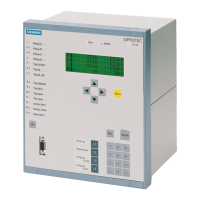Technical Data
4.12 Circuit Breaker Failure Protection (optional)
SIPROTEC, 7SD610, Manual
C53000-G1176-C145-6, Release date 02.2011
356
4.12 Circuit Breaker Failure Protection (optional)
Circuit breaker monitoring
Initiation conditions
1)
Via binary inputs
Times
Stub Fault Protection
Pole Discrepancy Supervision
Current flow monitoring for I
N
= 1 A 0.05 A to 20.00 A Increments 0.01 A
for I
N
= 5 A 0.25 A to 100.00 A
Zero sequence current monitoring for I
N
= 1 A 0.05 A to 20.00 A Increments 0.01 A
for I
N
= 5 A 0.25 A to 100.00 A
Dropout to pickup ratio Approx. 0.95
Tolerance 5 % of set value or 1 % of nominal current
Monitoring of circuit breaker auxiliary contact position
for 3-pole tripping binary input for CB auxiliary contact
for 1-pole tripping 1 binary input for auxiliary contact per pole or
1 binary input for series connection NO contact and NC contact
Note
:
The circuit breaker failure protection can also operate without the indicated circuit breaker auxiliary contacts, but the func-
tion range is then reduced.
Auxiliary contacts are necessary for the circuit breaker failure protection for tripping without or with a very low current flow
(e.g. Buchholz protection) and for stub fault protection and circuit breaker pole discrepancy supervision.
For circuit breaker failure protection Internal or external 1-pole trip
1)
Internal or external 3-pole trip
1)
Internal or external 3-pole trip without current
1)
Pickup time Approx. 5 ms with measured quantities present
Approx. 20 ms after switch-on of measured quantities
Dropout time, internal (overshoot time) ≤ 15 ms at sinusoidal measured values,
≤ 25 ms maximal
Delay times for all stages 0.00 s to 30.00 s; ∞ Increments 0.01 s
Tolerance 1 % of setting value or 10 ms
With signal transmission to the opposite line end
Time delay 0.00 s to 30.00 s; ∞ Increments 0.01 s
Tolerance 1 % of setting value or 10 ms
Initiation criterion Not all poles are closed or open
Monitoring time 0.00 s to 30.00 s; ∞ Increments 0.01 s
Tolerance 1 % of setting value or 10 ms
